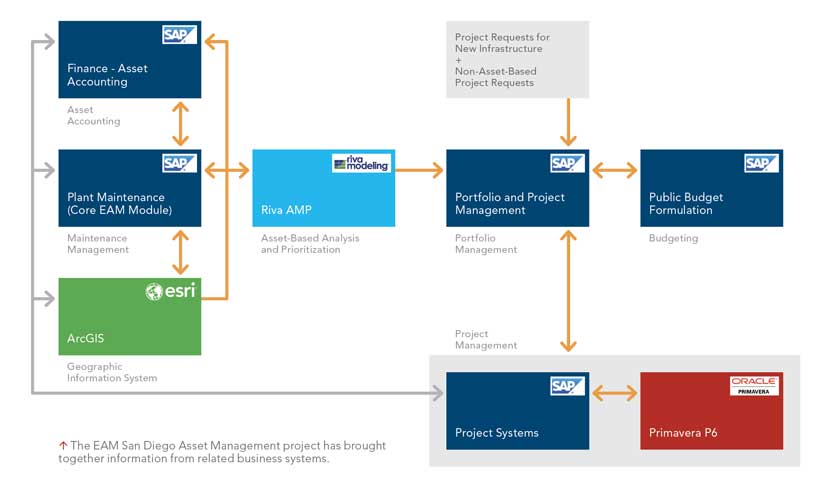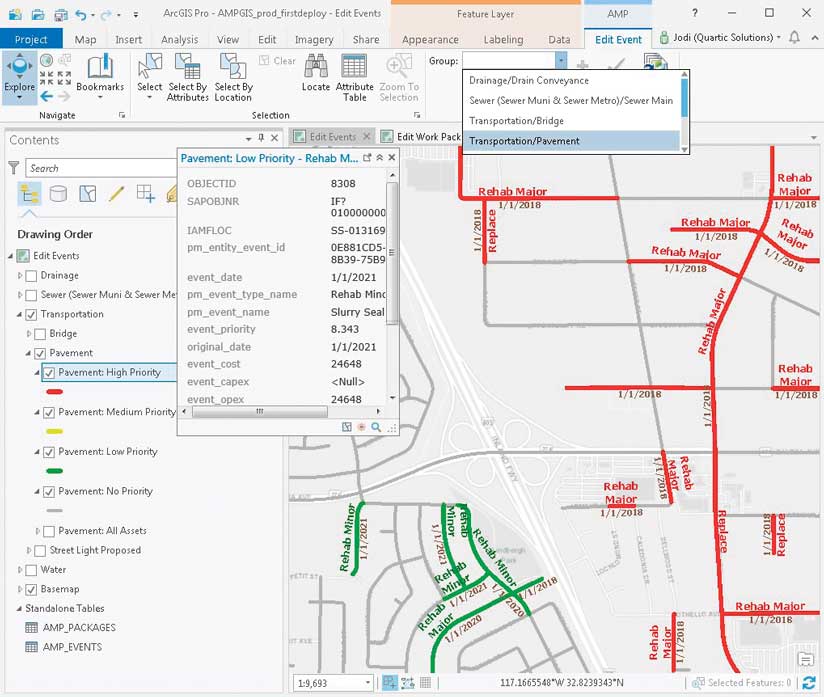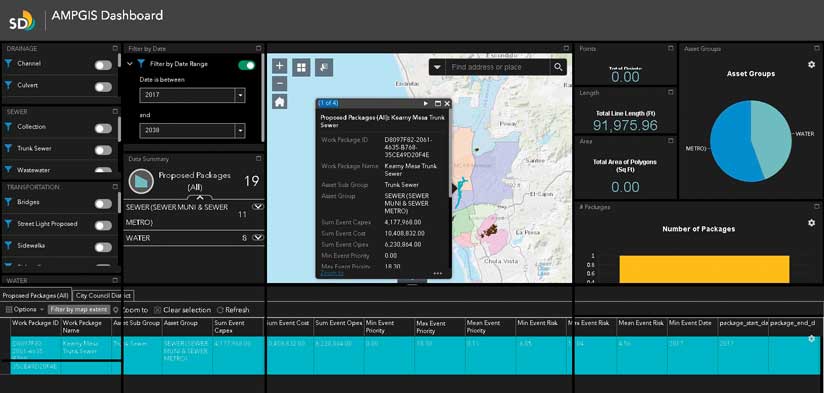In 2018, the City of San Diego, California, rolled out the first phase of a software solution, the SAP Enterprise Asset Management (EAM) module, to improve its infrastructure management. This tool is used for asset planning, capital asset management (including the Capital Improvements Program), and the city’s financial plan for the repair and/or construction of municipal infrastructure.
The city, which owns and maintains a large and complex network of infrastructure assets valued in the billions, has aging and deteriorating assets and a backlog of deferred maintenance and capital projects. The EAM San Diego project is an ongoing citywide strategic initiative to develop and implement a software solution.

GIS plays a critical role in asset management by applying spatial data structures, geographic relationships, and location-based functions to traditional database tables. The city has streamlined operations by standardizing on SAP as the work order system for operational asset maintenance and added spatial insight by incorporating Esri GIS technology.
Scott Daeschner, the city’s GIS manager, said, “The fusion of familiar GIS interfaces and tools with [the] powerful SAP enterprise workflow is making it easier to manage assets across all levels. Our users are familiar with GIS displays and are comfortable using standardized mapping symbols, relationships, and spatial functions.”
Esri partner Quartic Solutions LLC, a GIS consulting firm, worked on the project. “One of the coolest things Quartic did was to apply that familiar mapping experience to the life cycle modeling product. Quartic’s mapping interface minimized training costs, significantly enhanced [the tool’s] immediate utility and seamlessly transitioned staff to new tech via a familiar UX,” said Daeschner.
The EAM San Diego project required that asset information include the geographic location and user tools that enable staff to identify and answer location-based questions. For example, viewing active work orders on a map allows staff to identify clusters of work and more efficiently plan and schedule the city’s multiyear capital plan. GIS requirements were met by implementing desktop, web, and mobile GIS components.
GIS components enable holistic planning and prioritization of infrastructure investments across departmental lines. Using a systematic approach will increase the long-term stability and sustainability of the city’s asset management program. GIS helped institute an objective and transparent process that provides internal and external stakeholders with a clear view of what the city is investing in and why. The bidirectional syncing of SAP and enterprise GIS data allows more dynamic and accurate operational decision-making.
For capital planning, an application named AMPGIS was developed which combines the asset maintenance history and prioritization information stored in the city’s SAP and Powerplan Asset Investment Optimization software with the city’s Esri-based enterprise GIS system. AMPGIS was implemented using the SAP HANA ODBC [Open Database Connectivity] driver with ArcGIS clients and the ArcGIS Pro SDK. These combined technologies enable staff to visualize the distribution and extent of planned rehab and replacement jobs throughout the city.

AMPGIS Desktop is deployed to users as an ArcGIS Pro add-in that consists of an interactive map and specialized tools for grouping identified capital jobs based on geographic proximity to other similar job types, enabling the city to stay within its annual budget targets while working with planning time frames spread across 10 to 15 years.
Using AMPGIS, city engineers can visualize the dispersion, clusters, and extent of the proposed work packages by project type and prioritization ranking. AMPGIS tools enable staff to directly insert a new proposed work event using the map and update an existing prioritization category or package grouping. Also, communication between SAP and GIS is bidirectional. For example, if a user modifies a priority value ranking or group assignment in the SAP client interface, the value will be re-read and redrawn on the map when the map refreshes.
This desktop application was designed, developed, and implemented during a six-month time frame. It went live in summer 2018 as the Public Utilities, Transportation and Storm Water, and Public Works departments reengineered processes for identifying and prioritizing rehab and replacement projects.
While the AMPGIS ArcGIS Pro application is primarily used by engineers to schedule and group work packages by time and location, Portal for ArcGIS is used as the underlying technology for a dashboard used by city planners and managers across multiple departments to review the proposed transportation, water, and wastewater capital work locations. The dashboard allows city staff to view where the planned work is, check for conflicts, and identify opportunities for coordination or schedule improvements. The dashboard provides maps and charts summarizing statistics such as total cost, total pipe lengths, and asset counts by work package type and location.
The EAM San Diego project is a critical step toward the full replacement of existing disparate and outdated maintenance management systems that were used by the departments participating in the initial phase of the project. By using current EAM and GIS technology, the capital asset maintenance process has become more systematic and transparent across departments.

The EAM system has helped transform the city’s approach to maintenance from a reactive one to a proactive one that is based on life cycle management. Minimizing life cycle costs for assets optimizes the city’s limited funds. Tools that enable the city to better prioritize work allow the city to be more proactive. The solution supports predictive and corrective maintenance of asset-intensive operations, inspections, and condition assessments. By effectively managing capital assets, the city minimizes the total cost of owning and operating assets over their life cycle while delivering desired service levels to constituents.
For more information, contact Gerard Lonergan, EAM project manager, Department of Information Technology, City of San Diego, California.

